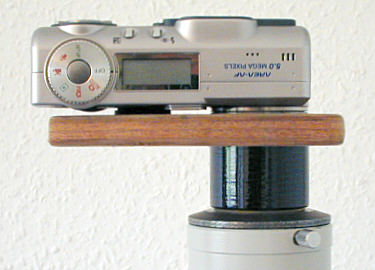 |
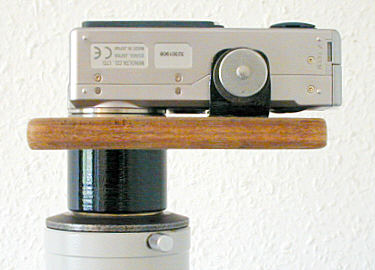 |
| Mounting
Digicams With Zoom Lenses Over The Microscope Brief notes on the design of one universal mounting system which caters for two different cameras By Paul James (uk) |
One of the problems of mounting a modern digicam over the microscope entails the marriage of its ever changing zoom to the Ramsden's disc above the eyepiece so that all the parameters of field capture, even illumination, and centration can be realised without damaging the variable zoom assembly. I also wanted to use another camera on the mount which complicated the matter further since the two cameras were entirely different.
Most lens assemblies on digicams move during zooming, and many of these have fully retractable one's too. This translates into having to mount the camera either by the main body and or use of the tripod mount bush. Few cameras have internal moving optics, but these are far easier to mount above the eyepiece because they can be attached to the 'scope's drawtubing/trinocular port with a filter threaded coupling device. This article is concerned with the mounting of a Minolta F300 which is of the retractable zoom lens type, and a Nikon Coolpix 800 which has an internally moving zoom lens, over a trinocular port.
The method below is basically a very simple one : I wanted a solid yet very simply set-up system which could be up and 'running' in seconds, and that was easily adjustable too. This 'convenience of use' philosophy usually entails quite a bit of thought and work, but for me it was well worth the trouble, for once it was made, the simplicity and convenience in its use was a bonus. Simpler mountings can be made more quickly but they usually entail far more time to setup for each photo session.
 |
 |
The general design is simple enough and is essentially a metal 'cup' with its top recessed or rebated to receive the 1st camera lens body ring, and its bottom bored out and threaded with a 28mm filter thread which would accept the 2nd camera when necessary*.
 |
Shown above is the Minolta F300 in place. The camera is also supported by a tripod mount bracket attached to a piece of good quality ply which is a tight flush fit around the metal 'cup'. The camera's body boundary ring shown above seats easily but without more than about 0.1 mm play in the top face of the cylinder machined for the purpose. The critical distance between this rim and bottom of the cylinder allows full extension of the zoom so allowing its intimate positioning within the Ramsden disc that emerges from the eyepiece. Note the collar shown around the eyepiece which in all probability will be required so that both the observational focus at the binocular head is coincident with the eyepiece focus in the trinocular port. It is also important that lateral adjustment be allowed for final tweaking of the camera's axial position with regard to the optical axis.
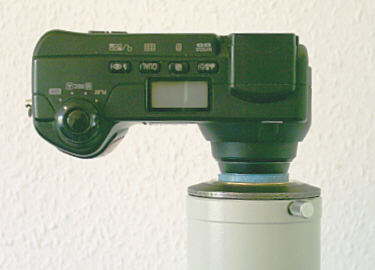 |
Shown above is the Nikon Coolpix 800 in place using the 28mm filter thread machined in the lower part of the fitment. It is a much simpler set-up, though the blue plastic washer is there to prevent the front lens glass cover from being marked by the thread of the collar which is too long for the Coolpix 800. Either camera can be installed within a few seconds, and the only further adjustment is to optimise the proximity of the lens/eyepiece distance using the 'slider' :-
The case for a 'sliding' camera tube support
 |
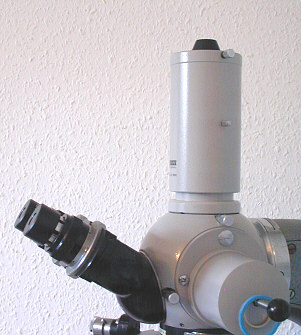 |
Any sensible professional fitment for photomicroscopy will have an inherent adjustment which allows the camera's lens or film plane to be rapidly moved to or from the eyepiece. This is not essential, BUT highly desirable and therefore heartily recommended. The image below shows Zeiss's version of this arrangement which allows about 40mm adjustment which I find more than sufficient for my needs. The outer cylinder slides over the inner tube which supports the eyepiece, so that effectively the camera lens's position can be rapidly but accurately adjusted if necessary for any zoom setting. I have fashioned the inner surface of the lower assembly that fits the Zeiss dovetail mount so that even if the outer slide tube is allowed to descend to its lower limit, the eyepiece connot protrude and damage the zoom's front element :-
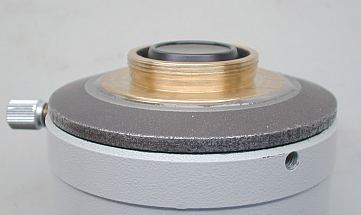 |
If you have a digicam and want to mount it in a similar way then it is essential that you provide clearance for the zoom, and ideally a sliding tube assembly which allows fine tuning of the camera's position for various settings of the zoom.
Conclusive points
Relying on a hit and miss set-up is not the way to go, since the setting up will entail a lengthy process each time the camera is offered to the eyepiece.........a recipe for limited photographic interest?? If you are only interested in an occasional image from the microscope then hand support is a practical proposition with firm base for both hands beside the eyepiece.
In a nutshell........the more thought and effort you put into your set-up assembly, the less time you'll spend on wasteful and unecessary procedures, which will result in more frustration and eventually prove counterproductive.
Digicams are more durable and longer living than one would reasonably expect, so the making of a sensibly adjustable set-up, that can be relied on to be accurate on each occasion is well worth considering.
The materials for the above assembly were gleaned from a redundant pulley wheel, a water tap part, scrap marine ply, an offcut of steel bar, alloy plate and a 1/4" thread plus knurled thumb 'wheel' for the tripod bush.
Simplicity is the essence of success, both in the excecution of the idea, and in its conception.
INFRA RED REMOTE CONTROLLERS
Some digicams are designed to be used with small infra red remote controllers. The Minolta and also Olympus range have this facility, which is exceedingly useful in photomicroscopy.
The ability to release the shutter without touching the camera, as and when you require this is ideal, and I'd recommend it heartily to anyone who is still undecided in their choice of digicam to consider this facility. Despite my comments in last month's article which described the problems of the Minolta F300's susceptibility to producing 'rings' in certain forms of photomicroscopic imagery, the camera is still very capable of providing quality imagery in BF and DF. The IR remote controller is the gilding on the lily!!
| All comments welcome to the author Paul James |
Microscopy
UK Front Page
Micscape
Magazine
Article
Library
Please report any Web problems or offer general comments to the Micscape Editor.
Micscape is the on-line monthly magazine of the Microscopy
UK web
site at Microscopy-UK